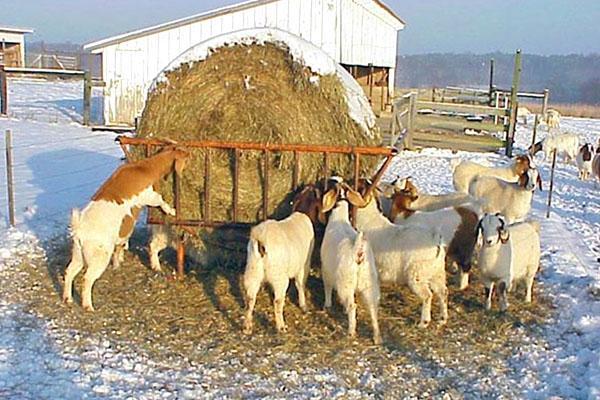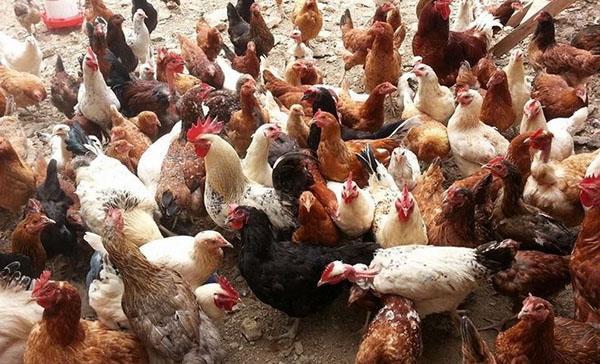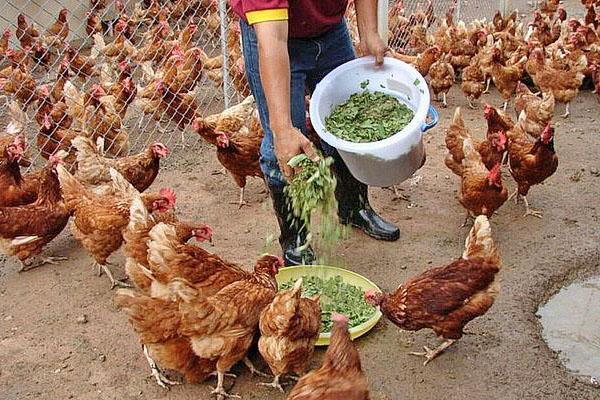Hot February at the farm
 For many summer residents, winter is a time of respite from gardening and gardening work, which cannot be said about those who raise pets. These brave people work incessantly on the farm all year round, and February is a special month for them. After all, right now it is important to feed the chickens with high quality, take care of newborn goats and lambs. And also do not forget about the bees that are waiting for feeding. Such a lot of work involves a lot of effort, but the result is sure to bring joy and satisfaction.
For many summer residents, winter is a time of respite from gardening and gardening work, which cannot be said about those who raise pets. These brave people work incessantly on the farm all year round, and February is a special month for them. After all, right now it is important to feed the chickens with high quality, take care of newborn goats and lambs. And also do not forget about the bees that are waiting for feeding. Such a lot of work involves a lot of effort, but the result is sure to bring joy and satisfaction.
Secrets of Feeding Chickens

 Prudent owners even in the summer think about what to feed the chickens in winter. They harvest nettles, prepare pine needle flour, and grow various vegetables.
Prudent owners even in the summer think about what to feed the chickens in winter. They harvest nettles, prepare pine needle flour, and grow various vegetables.  Thanks to this approach, the bird receives all the necessary components for a healthy existence and produces a high-quality egg.
Thanks to this approach, the bird receives all the necessary components for a healthy existence and produces a high-quality egg.
If the outside temperature is -20 ° C, the bird is fed twice a day. With a greater strength of frost, use three meals a day.
When it's February, every morning it is advisable to give chickens the following feed:
- mash;
- boiled porridge with the addition of cottage cheese;
- herbal flour from dry nettle;
- chopped needles with a dry set of vitamins and minerals;
- boiled root vegetables;
- finely chopped cabbage leaves.
 In the evening, the bird will benefit from dry food, which consists of various types of grain. It is not a problem if the mixture is left in the trough overnight, as it does not lose nutritional value at low temperatures.
In the evening, the bird will benefit from dry food, which consists of various types of grain. It is not a problem if the mixture is left in the trough overnight, as it does not lose nutritional value at low temperatures.
 To make the egg of high quality, you can add worms to the feed. It doesn't matter that it's winter outside. For example, maggots are sold in fishing shops. What can't you do for the sake of birds dear to your heart? To summarize, we can say that the daily diet of poultry is quite simple. But the benefits are much more valuable than the costs.
To make the egg of high quality, you can add worms to the feed. It doesn't matter that it's winter outside. For example, maggots are sold in fishing shops. What can't you do for the sake of birds dear to your heart? To summarize, we can say that the daily diet of poultry is quite simple. But the benefits are much more valuable than the costs.
Collection of eggs for the incubator
 So that there are always chickens on the farm, at the end of winter it's time to cook eggs for the incubator. Since frosts do not stop in February, you should adhere to the following rules:
So that there are always chickens on the farm, at the end of winter it's time to cook eggs for the incubator. Since frosts do not stop in February, you should adhere to the following rules:
- Collect eggs 2 times a day (when they are still warm). This preserves the incubation properties.

- Store raw materials in a cool dry place (temperature about 12 ° C, humidity within 80%).

- Eggs should only be laid horizontally. The optimal shelf life is no more than a week.
Stained eggs should never be washed. Better to choose clean options. Everything should be natural. The earlier they are in the incubator, the greater the likelihood of chicks being born.
 Basic requirements for incubation material:
Basic requirements for incubation material:
- Correct shape without visible damage.
- The yolk is located in the central part of the egg.

- The air chamber is on the blunt side.
- When translucent, the content should be light.
It is equally important to choose medium sized eggs. Practice shows that in large specimens there are hidden defects, and small ones lead to the appearance of weak specimens. Having completed such works in February, the yard will be filled with young chickens in the fall.And then quality eggs will regularly be on the table.
Anxious care for newborn kids and lambs
 The most responsible care in the farm is taking care of newborn animals. Helpless kids need human attention and help when it's freezing and snowy outside. Therefore, summer residents are trying to make every effort to raise healthy pets. An ancient book says that a caring shepherd lovingly treats his livestock, especially newborn cubs.
The most responsible care in the farm is taking care of newborn animals. Helpless kids need human attention and help when it's freezing and snowy outside. Therefore, summer residents are trying to make every effort to raise healthy pets. An ancient book says that a caring shepherd lovingly treats his livestock, especially newborn cubs.
The first thing new kids need is release from the umbilical cord. It is trimmed with clean, sharp scissors, leaving 2 cm from the body. After that, blood is squeezed out of it and dipped for a moment in iodine. For several hours it is necessary to monitor her condition in order to notice possible bleeding. If this happens, you need to quickly tie the umbilical cord with a simple thread and treat the wound with iodine. You do not need to remove it, after 14 days it will fall off with the remains of the umbilical cord.
If several kids were born, the scissors should be disinfected after each individual to avoid contamination.
 Since the kid is born very weak, the best food for him is colostrum. It is given to the animal 2 hours after birth. For the first week, it feeds exclusively on milk from the mother, which is filtered and heated. Feeding mode - up to five times a day. After 2 weeks, the baby is taught to eat solid food by putting hay in the feeder. Even in February, it is recommended to release young animals for a walk, if it is not too cold outside.
Since the kid is born very weak, the best food for him is colostrum. It is given to the animal 2 hours after birth. For the first week, it feeds exclusively on milk from the mother, which is filtered and heated. Feeding mode - up to five times a day. After 2 weeks, the baby is taught to eat solid food by putting hay in the feeder. Even in February, it is recommended to release young animals for a walk, if it is not too cold outside.
 Newborn lambs need full care of their owners, especially during the cold weather in February. To prevent them from catching cold, a container with hot water or a reflector is brought into the room. As a result, they dry out quickly and after 40 minutes are ready to connect with their mother.
Newborn lambs need full care of their owners, especially during the cold weather in February. To prevent them from catching cold, a container with hot water or a reflector is brought into the room. As a result, they dry out quickly and after 40 minutes are ready to connect with their mother.
 For the first few days, they eat only milk. They are brought up to the uterus every 2 or 3 hours. Wise summer residents keep track of the time so that the kids do not go hungry. Lambs, which are weaker than others, are fed with milked milk. Anxious care of newborn lambs in February is a guarantee of healthy sheep in the farm.
For the first few days, they eat only milk. They are brought up to the uterus every 2 or 3 hours. Wise summer residents keep track of the time so that the kids do not go hungry. Lambs, which are weaker than others, are fed with milked milk. Anxious care of newborn lambs in February is a guarantee of healthy sheep in the farm.
In the early days, the sheep are fed mainly with hay, which is an excellent source of milk. Only on day 5 is she given a full diet.
Forced feeding of bees
 On cold February days, bee colonies should not be forgotten. While they are at rest, it is important to make sure they have food at all times. If there is not enough honey in the hive, you need to prepare top dressing:
On cold February days, bee colonies should not be forgotten. While they are at rest, it is important to make sure they have food at all times. If there is not enough honey in the hive, you need to prepare top dressing:
- sugar syrup;

- sugar dough;

- sugar candy.

Prepare the sugar syrup in an enamel saucepan. 1 liter of water is poured into it and brought to a boiling state. Then add 2 kg of sugar and, stirring, cook for about 20 minutes. When the product turns out to be made into balls, then it is ready. Honey (600 g) is added to this mixture and boiled for another 2 or 3 minutes. The cooled syrup is vigorously stirred with a wooden spoon until a white mass is obtained. Small cakes are made from it, wrapped in cloth and placed in the hive near the bees.
Sugar dough is prepared by mixing powdered sugar (2 kg) with honey (1 kg). When a homogeneous mass is formed, it is kneaded like a regular dough. When finished, it should retain its shape for 3 hours. It is distributed to bees in the same way as sugar syrup.
Sugar candy is made from 1 part water and 5 parts granulated sugar. The slush is boiled over low heat for about half an hour. You can add citric acid (2 g) to it to get a clear candy. If the sugar is stretching like a string, the feed is ready. The hot product is poured into special frames, which are later placed in the hive next to the bee family club.
Any feeding of bees during the winter dormancy can agitate insects. It is used only in extreme cases to protect faithful workers from starvation.